This is the first in a series introducing
the activity model in the Unified Modeling Language, version 2 (UML
2), and how it integrates with the action model [1].
The series is a companion to the standard, providing additional
background, rationale, examples, and introducing concepts in a logical
order. This article covers motivation and architecture for the new
models, basic aspects of UML 2 activities and actions, and introduces
the general notion of behavior in UML 2.
1 BACKGROUND
A focus of recent
developments in UML has been on procedures and processes. UML
1.5 introduced a model for parameterized procedures defined by
control and data flow to complement the existing state and interaction
models [2]. For the first time UML supports
first-class procedures that can be used as methods on objects
or independently of objects, as occurs when modeling, for example,
function libraries with popular programming languages. It also
facilitates application of UML by modelers who do not use object-orientation
(OO) routinely, such as system engineers and enterprise modelers,
and provides them a path to incrementally adopt OO as needed [3].
The flexibility to combine OO with functional approaches considerably
widens and integrates the potential applications of UML.

Figure 1: UML Timeline
UML 1.5 also inherited
from earlier versions a form of state machine that was notationally
modified to appear as a flow diagram, called the activity diagram.
Unfortunately, the underlying state machine semantics restricts
expressiveness and is confusing to users. Especially those not
using an OO approach perceive UML 1.x activity models as not working
for them. There is also concern that UML 1.5 has multiple models
for control and data flow.
In light of this
experience, UML 2.0 redefined the activity model to give it a
basis in flow modeling intuition, and to integrate it with the
UML 1.5 action model. The new activity model supports the control
and data flow of UML 1.5 procedures, as well as more general features,
such as cycles and queuing. Consequently, UML 2 activities support
flow modeling across a wide variety of domains, from computational
to physical. This makes it ideal for specifying systems independently
of whether the implementation is software or hardware, as in system
engineering, and independently of where the system/environment
boundary is drawn. Finally, the combination of activities and
actions retains the UML 1.x capability of reacting to events,
so can be applied to areas requiring that, such as embedded and
agent-based systems.
2 MULTIPLE DOMAINS
Although the UML
2 activity and action models are defined independently of application,
some features are more appropriate to some domain styles than
others. For example, actions for throwing exceptions will probably
be used more often by programmers, whereas enterprise modelers
are more likely to apply other techniques for atypical flows,
such as exception parameters and interrupting regions. This redundancy
is unavoidable when creating an abstraction over user groups that
do not overlap. However, it is more than made up for by the efficiency
in communication based on a common model between domains that
are integrated in delivered systems.
To support vendors
focusing on particular users, the activity model is packaged in
a more fine-grained way than other behavior models, and has more
complex dependencies between packages, as shown in Figure 2.
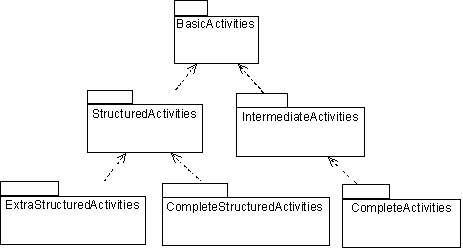
Figure 2: Activity
Package Dependencies
The features in common
between the applications, such as the abstract action concept,
control/data flow, and input/output, are at the root (basic activities).
From there, dependencies branches in two directions, one mainly
for software modeling (structured activities), and the other for
general process modeling (intermediate and complete activities).
Structured activities introduce well-nested constructs, for modeling
conditionals, variables, try/catch, and so on. Intermediate and
complete activities introduce explicit parallelism, partitions,
flow-based forms of exception handling, and a number of constructs
for finer-grained control of flows. These are orthogonal branches,
so they may be combined. For example, structured activities may
be folded in with intermediate activities, to support explicit
parallelism and structured conditionals at the same time1.
This series will cover the functionality of the various packages.
Supporting a wide
range of applications also requires multiple notations. For example,
programmers tend to favor textual notations, while subject matter
experts prefer graphical notations. UML addresses this by defining
a repository for storing specifications that can be populated
from multiple notations. Programmers can use a textual syntax
to build and read activity models in the repository, and enterprise
modelers can use a graphical notation. The UML repository is a
communication medium between multiple notations, and a source
for highly directable compilers targeting multiple platforms [4].
3 FLOW MODELS AND SEMANTICS
Behavior models in
general determine when other behaviors should start and what their
inputs are [3]. In particular, the UML 2 activity
models follow traditional control and data flow approaches by
initiating subbehaviors according to when others finish and when
inputs are available. It is typical for users of control and data
flow to visualize runtime effect by following lines in a diagram
from earlier to later end points, and to imagine control and data
moving along the lines. Consequently a token flow semantics inspired
by Petri nets is most intuitive for these users, where "token"
is just a general term for control and data values.
UML 2 takes the same
approach to behavioral semantics as UML 1.x, namely to define
intuitive virtual machines. This enables users and vendors to
predict the runtime effect of their models. UML 2 activities define
a virtual machine based on routing of control and data through
a graph of nodes connected by edges. Each node and edge defines
when control and data values move through it. These token movement
rules can be combined to predict the behavior of the entire graph2.
The rules for control and data movement are only intended to predict
runtime effect, that is, when behaviors will start and with what
inputs. They do not constrain implementation further than that.
In particular, the rules do not imply that activity models must
be implemented as a virtual machine corresponding to the token
analogy, messaging passing, or any other scheme. It is only necessary
that the runtime effects predicted by the virtual machine actually
occur in the implementation.
The activity model
is defined with few semantic variations, which is the UML term
for allowing implementations to choose alternative runtime behavior
without recording those choices in the model. Semantic variations
cause a model in one implementation to execute differently than
the same model in another implementation, with no standard way
to tell what the differences are. Variations in activity execution
are mostly modeled as attribute values in the user’s model. This
means they are under user control and are transmitted to other
users without requiring implicit alignment of implementations.
4 ACTIVITY NODES AND EDGES
UML 2 activities
contain nodes connected by edges to form a complete flow graph.
Control and data values flow along the edges and are operated
on by the nodes, routed to other nodes, or stored temporarily.
More specifically, there are three kinds of node in activity models:
- Action nodes operate on control
and data values that they receive, and provide control and data
to other actions.
- Control nodes route control
and data tokens through the graph. These include constructs
for choosing between alternative flows (decision points), for
proceeding along multiple flows in parallel (forks), and so
on.
- Object nodes hold data tokens
temporarily as they wait to move through the graph.
Figure 3 shows the notation for some of the activity nodes to
be discussed. Contrary to the names, control nodes coordinate
both data flow and control flow in the graph, and object nodes
can hold both objects and data3.
Activity nodes are
connected by two kinds of directed edges:
- Control flow edges connect
actions to indicate that the action at the target end of the
edge (the arrowhead) cannot start until the source action finishes.
Only control tokens can pass along control flow edges.
- Object flow edges connect objects
nodes to provide inputs to actions. Only objects and data tokens
can pass along object flow edges.
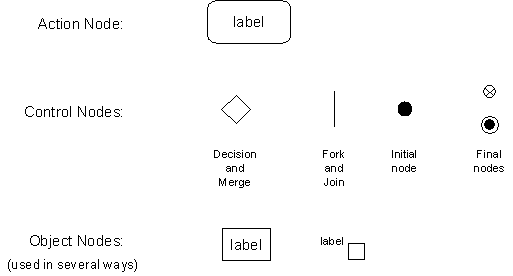
Figure 3: Activity
Nodes
Figure 4 shows the
notation for edges. Control and object flow edges are distinguished
by usage. Control edges connect actions directly, whereas object
flow edges connect the inputs and outputs of actions (see next
section).

Figure 4: Activity
Edges
This rest of this
article introduces actions and edges with a small example. Later
articles will cover the other kinds of nodes, and more features
of actions and edges.
5 ACTIONS
Activity models coordinate
actions, some of which may invoke user-defined behaviors, including
other activities. All actions are predefined. For example, UML
2 has actions to create objects, set attributes values, link objects
together, and to invoke user-defined behaviors. Actions can have
inputs and outputs, which are called pins, that are connected
by object flow edges to show how values flow through the activity,
provided by some actions and received by others. In the simple
cases, all inputs to an action are required to be available for
it to begin executing.
Figure 5 shows an
example of an action creating a new instance of an Order
class, then another action invoking a user-defined behavior to
fill it. The object creation action creates a blank order that
FillOrder completes. Action nodes
are notated with round cornered rectangles4,
5. At the top of Figure 5, the
small rectangles attached to the actions are input and output
pins. The type of object accepted as input or provided as output
is shown as an adornment. The notation at the bottom of Figure
5 can be used when the types of input and output are the same.
Pins are a kind of object node, so they also hold data values
temporarily in the flow.
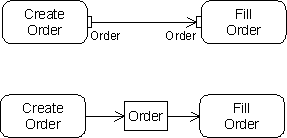
Figure 5: Example
Actions and Object Flow Edges
As mentioned before,
it is not necessary to use the notation of Figure 5. Programmers
will mostly likely prefer a textual notation [4],
such as:
Order
o;
o = new Order;
FillOrder(o);
The repository model
defined by UML 2 is the same for the above notations, as shown
in Figure 6, assuming the variables of the textual language are
modeled as dataflow6. Each
element of the repository is an instance of a metaclass defined
in the UML specification, which is the name to the right of the
colon. The name of the repository instance itself is to the left
of the colon, blank if it is anonymous. The model shows a CreateObjectAction
with an output pin passing its value to the input pin of a CallBehaviorAction.
The CreateObjectAction is linked
to the user class it instantiates (Order),
and the CallBehaviorAction is linked
to the user-defined behavior it invokes (FillOrder).
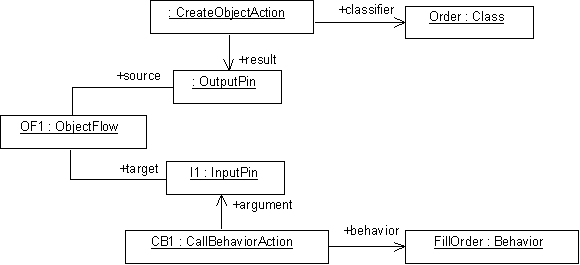
Figure 6: Repository
model for Figure 5
The primitive actions
for creating objects, invoking user-defined behaviors, and so
on, are not technically behaviors themselves, but this is more
an artifact of metamodeling than a conceptual distinction. The
fundamental distinction is between a specification of dynamic
effect and its usage, to support multiple usages of the same specification.
For example, the same FillOrder
behavior may be invoked in many activity diagrams, or many times
in the same activity diagram, but each invocation will be represented
by a separate instance of CallBehaviorAction
in the repository, all referring to the same FillOrder
behavior. This is because each usage of FillOrder
will be in a different flow, or at different points in the same
flow, and each usage may have different actions before and after
it. For example, Figure 6 has a CreateObjectAction
before FillOrder, whereas another
flow might not7.
Actions are also
reusable, but this happens to be modeled in a different way than
user-defined behaviors. Each action in a flow is a new instance
of a single class from the UML metamodel. For example, if an activity
contains two object creation action nodes, then the user’s repository
has two instances of the CreateObjectAction
class from the UML metamodel, and separate sets of pins for each.
Reusability is achieved by using multiple instances of the same
UML metaclass as action usages8.
Later articles will cover the various kinds of actions.
6 ACTIVITIES
Activities are user-defined
behaviors, and like all behaviors in UML 2 can be initiated by
invocation actions, and support parameters to receive and provide
data to the invoker. Parameters are part of the reusable definition
of an activity. Parameters are not pins, because pins are used
to connect actions in a flow, whereas activities are behaviors
invoked by actions (see previous section). However, to access
parameter values from actions in the activity, activity parameters
are modeled as a special kind of object node used to temporarily
hold actual parameter values as they flow into and out of the
activity. Figure 7 shows a parameterized activity with a parameter
object node connected to pins on actions. Parameter object nodes
are shown on the border, with object flow edges connecting them
to pins. The type of object held in an object node is usually
shown in the label. In this example, the information used to fill
the order is provided as an input parameter and passed along to
the invocation of the FillOrder
behavior.
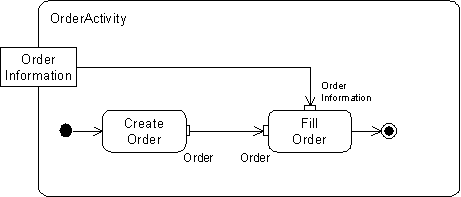
Figure 7: Example
Activity
The control nodes
at the beginning and end of the flow in Figure 6 are initial and
final nodes respectively. When the OrderActivity
is invoked, a control token is placed at the initial node, and
a data token with ordering information is placed at the input
parameter object node. The control token flows from the initial
node to the CreateOrder action,
which begins executing. The data token flows from the parameter
to the invocation action for FillOrder,
which must wait for CreateOrder
to provide its other input before starting. When FillOrder
is done, a control token is passed to the final node and the activity
terminates, returning control to execution that started it. A
partial repository model for Figure 7 is in Figure 8 below. It
connects to the repository model of Figure 6 through the CB1 CallBehaviorAction.
The CreateOrder action and its
flows are omitted for brevity.
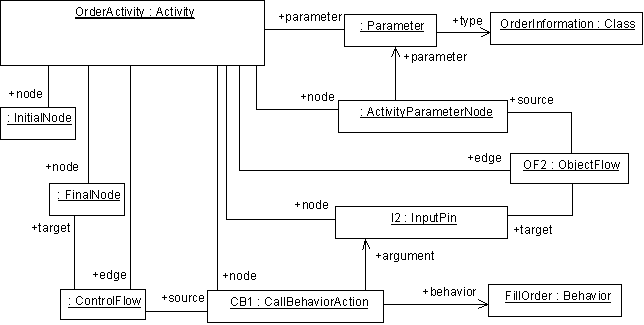
Figure 8: Partial
repository model for Figure 7
7 BEHAVIOR IN UML 2
UML 2 supports the
concept of parameterized behavior for all the kinds of behavior
in UML, not just activities. This means state machines, interactions,
and activities all can be parameterized, and be methods on objects
or invoked directly, in a uniform way. The upper right of Figure
9 shows an activity model for a behavior called DeliverMail
(the curved arrows are not part of UML notation). DeliverMail
could be invoked as is with a CallBehaviorAction,
or as a method on the POEmployee
class with a CallOperationAction.
In either case, the behavior takes an instance of KEY as input.
Because behaviors can be invoked directly or as operations, UML
2 provides a path to incrementally adopt object-orientation [3].
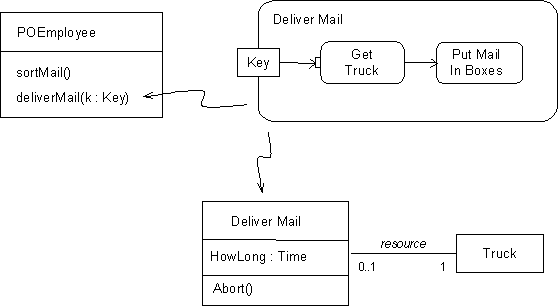
Figure 9: UML 2 Behavior
UML 2 user-defined
behaviors are also classes. Each time a behavior is executed at
runtime, a new runtime instance of the user’s behavior class is
created. The instance is destroyed when the behavior terminates.
Behavior classes, like all classes, can support attributes, associations,
operations, and even other behaviors, such as state machines.
This reflects common practice in systems that manage processes,
for example, workflow and operating systems. The bottom of Figure
8 shows the behavior class for the DeliverMail
activity with an attribute for how long each execution of DeliverMail
has been running, an operation to abort the execution, and an
association for the truck it is using. Applications can also put
state machines on the behavior class to describe the status of
each execution, such as NOT_STARTED, SUSPENDED, and so on [5]
[6].
UML 2 behavior classes
enable the definition of standard functionality for process management,
even though UML 2 does not define standard features itself. Behavior
class features can be defined by domain standards, vendors, or
user groups as reusable model libraries containing abstract behavior
classes with normative attributes and operations such as ABORT
and so on. Then these classes can be used as supertypes of user-defined
behaviors such as DeliverMail in
Figure 9.
8 CONCLUSION
This article begins
a series on the UML 2 activity and action models. It reviews progress
in UML flow modeling, package structure needed to serve the wide
range of flow modeling applications, UML's approach to semantics,
then introduces some basic elements of activity modeling, and
the UML 2 behavior model generally.
Footnotes
1The
action model should be finely packaged to correspond with activities,
but is currently divided into IntermediateActions
and CompleteActions only. These
contain the predefined actions, such as object creation, setting
attributes, and so on. The abstract notion of action is defined
in the BasicActivities package
because it is integral to the flow model. See later sections of
this article.
2It
is hoped that the rules are precise enough to be translated to
a formal semantics, especially to support proving properties about
modeled processes. This is left for future work.
3UML
abstracts from objects and data to classifiers in general.
4The
wording inside the action nodes is not normative, because a standard
textual notation for actions is not adopted yet. Also action nodes
can be given labels that are more descriptive than the predefined
action name.
5The
round cornered notation is also used by state machines to notate
states, unfortunately. This is not a desirable situation. However,
it is beneficial to those users and vendors who have been trying
to apply state machines to flow modeling applications, for lack
of a flow modeling standard until now.
6UML
1.5 and UML 2 also support variables if needed.
7Programming
languages make the same distinction between a procedure declaration
or definition, which has the signature, and statements that call
the procedure, providing actual parameters at runtime. In UML
2 terms, a procedure definition is a behavior, and a statement
is an action.
8It
is possible that actions could be modeled in the same way as user-defined
behaviors and be standardized as a reusable model library. Then
only one predefined action would be needed to invoke all behaviors,
whether predefined or user-defined. However, the static requirements
of predefined actions, such as CreateObjectAction
requiring a class to instantiate, would need to be recorded in
constraints rather than associations in the metamodel. Constraints
are generally not as easy to read in the UML specification as
metamodel associations.
ACKNOWLEDGEMENTS
Thanks to Evan Wallace
and James Odell for their input to this article.
REFERENCES
[1]
U2 Partners, “Unified Modeling Language: Superstructure”, version
2.0, 3rd revised submission to OMG RFP ad/00-09-02, http://www.omg.org/cgi-bin/doc?ad/2003-04-01,
April 2003.
[2]
Object Management Group, “OMG Unified Modeling Language”, version
1.5, http://www.omg.org/cgi-bin/doc?formal/03-03-01,
March 2003.
[3]
Bock, Conrad, "Three Kinds of Behavior Model," Journal
of Object-Oriented Programming, 12:4, July/August 1999.
[4]
Bock, Conrad, “UML Without Pictures”, to appear in IEEE Computer
Special Issue on Model-driven Development, September/October 2003.
[5]
Object Management Group, “Workflow Management Facility Specification”,
version 1.2, http://www.omg.org/cgi-bin/doc?formal/00-05-02,
May 2000.
[6]
Workflow Management Coalition, “Workflow Standard - Interoperability
Abstract Specification”, http://www.wfmc.org/standards/docs/TC-1012_Nov_99.pdf,
November 1999.
About the author

|
 |
Conrad
Bock is a Computer Scientist at the National Institute of
Standards and Technology. He is the workgroup lead for activities
and actions in the UML 2 submission team, and can be reached
at conrad.bock at nist.gov.
|
Cite this column
as follows: Conrad Bock: “UML 2 Activity and Action Models”, in
Journal of Object Technology, vol. 2, no. 4, July-August 2003,
pp. 43-53. http://www.jot.fm/issues/issue_2003_07/column3









